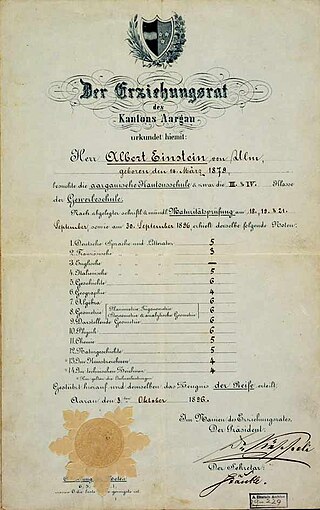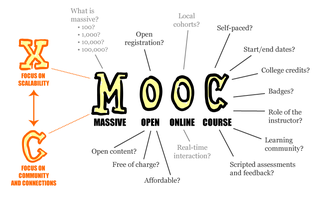
A textbook is a book containing a comprehensive compilation of content in a branch of study with the intention of explaining it. Textbooks are produced to meet the needs of educators, usually at educational institutions. Schoolbooks are textbooks and other books used in schools. Today, many textbooks are published in both print and digital formats.
Educational assessment or educational evaluation is the systematic process of documenting and using empirical data on the knowledge, skill, attitudes, aptitude and beliefs to refine programs and improve student learning. Assessment data can be obtained from directly examining student work to assess the achievement of learning outcomes or can be based on data from which one can make inferences about learning. Assessment is often used interchangeably with test, but not limited to tests. Assessment can focus on the individual learner, the learning community, a course, an academic program, the institution, or the educational system as a whole. The word "assessment" came into use in an educational context after the Second World War.

CheddarU is an American closed-circuit network available on 600 U.S. college campuses owned by Cheddar, as part of internally originated cable systems that are a part of on-campus housing or college closed-circuit television systems. In 2018, Cheddar acquired MTV Networks on Campus, a former division of Viacom, to launch the channel. Cheddar also acquired RateMyProfessors.com, which was part of the MTVU division since 2007, in October 2018.
A learning management system (LMS) or virtual learning environment (VLE) is a software application for the administration, documentation, tracking, reporting, automation, and delivery of educational courses, training programs, materials or learning and development programs. The learning management system concept emerged directly from e-Learning. Learning management systems make up the largest segment of the learning system market. The first introduction of the LMS was in the late 1990s. LMSs have been adopted by almost all higher education institutions in the English-speaking world. Learning management systems have faced a massive growth in usage due to the emphasis on remote learning during the COVID-19 pandemic.
RateMyTeachers.com (RMT) is a review site for rating K-12 and college teachers and courses. According to its website, its purpose is to help answer a single question: "what do I as a student need to know to maximize my chance of success in a given class?" As of April 2010, over eleven million teachers have been rated on the website.
In the realm of US education, a rubric is a "scoring guide used to evaluate the quality of students' constructed responses" according to James Popham. In simpler terms, it serves as a set of criteria for grading assignments. Typically presented in table format, rubrics contain evaluative criteria, quality definitions for various levels of achievement, and a scoring strategy. They play a dual role for teachers in marking assignments and for students in planning their work.
A virtual university provides higher education programs through electronic media, typically the Internet. Some are bricks-and-mortar institutions that provide online learning as part of their extended university courses while others solely offer online courses. They are regarded as a form of distance education. The goal of virtual universities is to provide access to the part of the population who would not be able to attend a physical campus, for reasons such as distance—in which students live too far from a physical campus to attend regular classes; and the need for flexibility—some students need the flexibility to study at home whenever it is convenient for them to do so.

Taylor's College is an independent college in Malaysia, offering the Cambridge A Levels as well as the South Australian Certificate of Education. It is ranked among the top Cambridge A Level college in Southeast Asia.
A course evaluation is a paper or electronic questionnaire, which requires a written or selected response answer to a series of questions in order to evaluate the instruction of a given course. The term may also refer to the completed survey form or a summary of responses to questionnaires.
A review site is a website on which reviews can be posted about people, businesses, products, or services. These sites may use Web 2.0 techniques to gather reviews from site users or may employ professional writers to author reviews on the topic of concern for the site.

The São Paulo State Technological Colleges are public institutions of higher education maintained by the State Center of Technological Education (CEETEPS). FATECs are important Brazilian institutions of higher education, being pioneers in the graduation of technologists. They are located in several cities of the São Paulo state, with four campuses in the capital, and several other units in the metropolitan region of São Paulo, countryside and seashore.

A Virtual Learning Environment (VLE) is a system specifically designed to facilitate the management of educational courses by teachers for their students. It predominantly relies on computer hardware and software, enabling distance learning. In North America, this concept is commonly denoted as a "Learning Management System" (LMS).

Academic standards are the benchmarks of quality and excellence in education such as the rigour of curricula and the difficulty of examinations. The creation of universal academic standards requires agreement on rubrics, criteria or other systems of coding academic achievement. At colleges and universities, faculty are under increasing pressure from administrators to award students good marks and grades without regard for those students' actual abilities, both to keep those students in school paying tuition and to boost the schools' graduation rates. Students often use course evaluations to criticize any instructor who they feel has been making the course too difficult, even if an objective evaluation would show that the course has been too easy. It is very difficult to find a direct correlation between the quality of the course and the outcome of the course evaluations.

The National Assessment Program – Literacy and Numeracy (NAPLAN) is a series of tests focused on basic skills that are administered to Australian students in year 3, 5, 7 and 9. These standardised tests assess students' reading, writing, language and numeracy and are administered by the Australian Curriculum, Assessment and Reporting Authority (ACARA). The National Assessment Program is overseen by the Education Ministers Meeting.

A massive open online course or an open online course is an online course aimed at unlimited participation and open access via the Web. In addition to traditional course materials, such as filmed lectures, readings, and problem sets, many MOOCs provide interactive courses with user forums or social media discussions to support community interactions among students, professors, and teaching assistants (TAs), as well as immediate feedback to quick quizzes and assignments. MOOCs are a widely researched development in distance education, first introduced in 2008, that emerged as a popular mode of learning in 2012, a year called the "Year of the MOOC".
StraighterLine is a U.S. educational company that offers low-price, online higher education courses that are equivalent to general courses required for a bachelor's degree. The American Council On Education’s College Credit Recommendation Service has evaluated and recommended college credit for StraighterLine courses. The company is itself unaccredited, but has over 150 partnerships with accredited colleges and universities that accept its courses for credit.

A flipped classroom is an instructional strategy and a type of blended learning. It aims to increase student engagement and learning by having pupils complete readings at home, and work on live problem-solving during class time. This pedagogical style moves activities, including those that may have traditionally been considered homework, into the classroom. With a flipped classroom, students watch online lectures, collaborate in online discussions, or carry out research at home, while actively engaging concepts in the classroom with a mentor's guidance.
A student bill of rights is a document that outlines beliefs or regulations regarding student rights, typically adopted by a student group, school, or government. These documents can be policies, laws, or statements of belief.

Produsage is a portmanteau of the words production and usage, coined by German-Australian media scholar Axel Bruns and popularized in his book Blogs, Wikipedia, Second Life and Beyond: From Production to Produsage. Produsage is the type of user-led content creation that takes place in a variety of online environments, open source software, and the blogosphere. The concept blurs the boundaries between passive consumption and active production. The distinction between producers and consumers or users of content has faded, as users play the role of producers whether they are aware of this role or not. The hybrid term produser refers to an individual who is engaged in the activity of produsage. This concept is similar and related to commons-based peer production, a term coined by Yochai Benkler.

MTVU is an American digital cable TV channel owned by the MTV Entertainment Group, a unit of the Paramount Media Networks division of Paramount Global. The channel was first known as VH1 Uno from 2000 to 2004 before changing names when Viacom expanded MTVU programming beyond more than 750 college and university campuses across the United States, as part of internally originated cable systems that are a part of on-campus housing or college closed-circuit television systems to digital cable in all homes. Music videos played on the channel primarily consist of indie rock, pop punk and hip-hop along with limited original programming. MTVU also launched a short-lived campus guide and social media network called Campusdailyguide.com in 2008.










